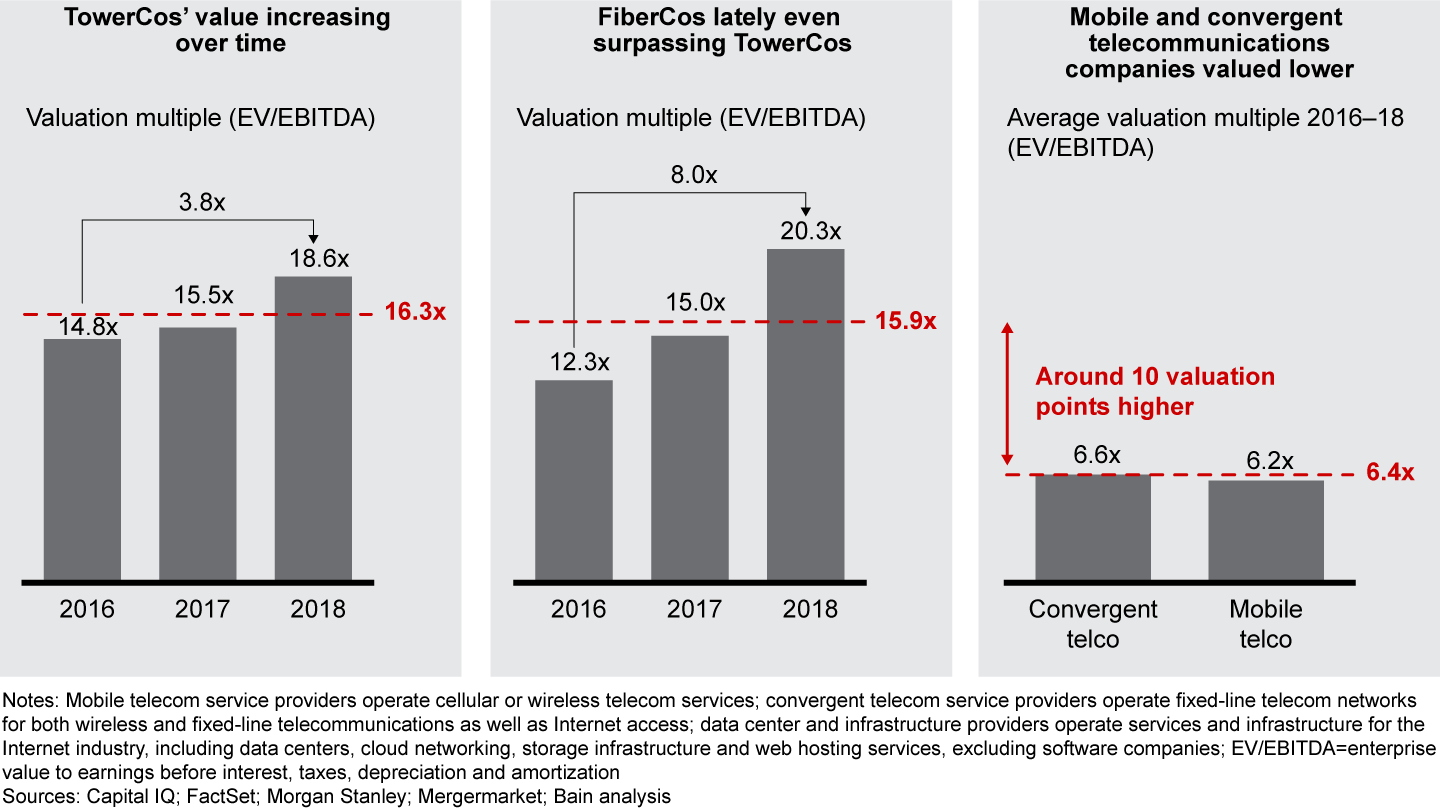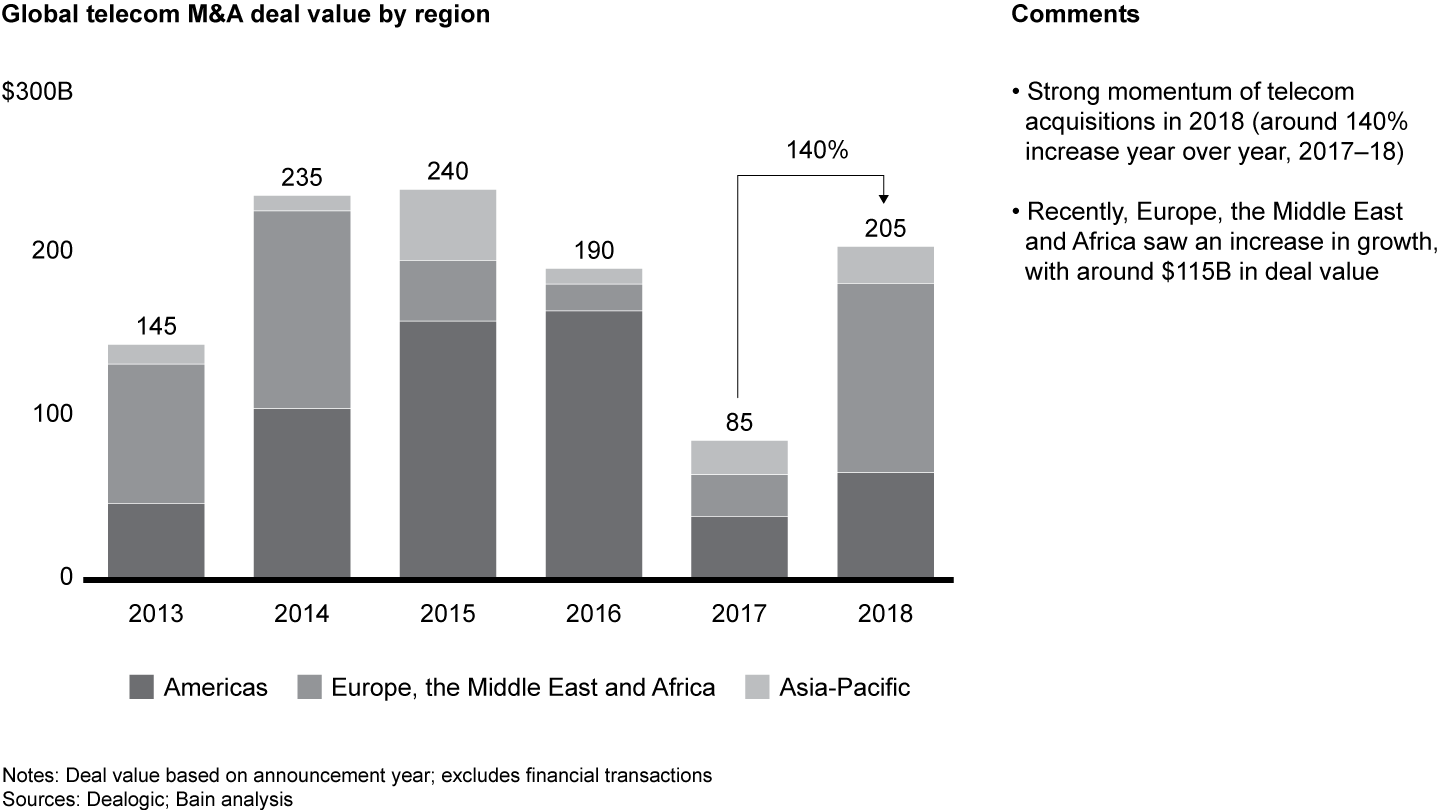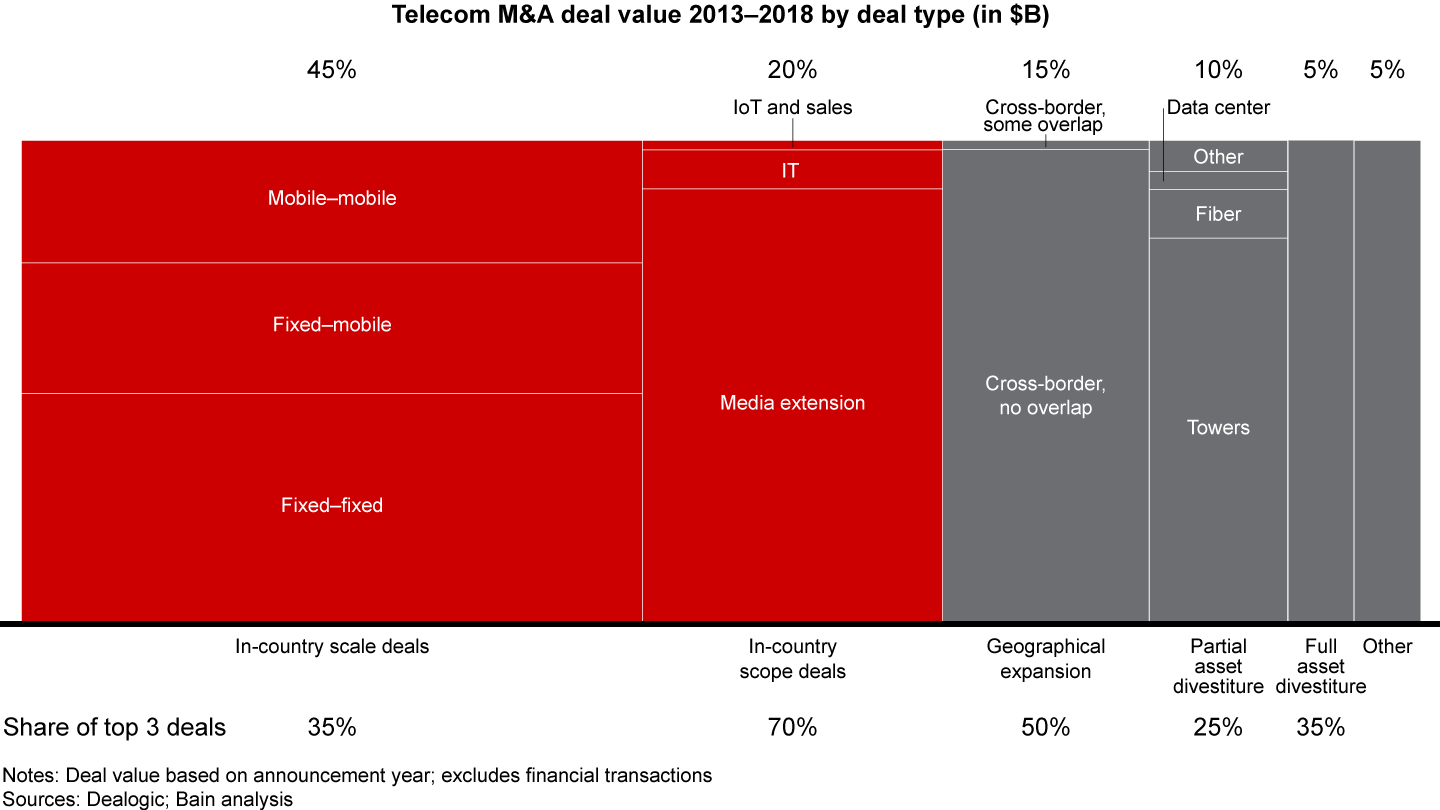Brief
 }
}
In evidenza
- Telecommunications companies are struggling to grow in a mature industry during a time when they feel pressure to upgrade and roll out their networks.
- Our research has identified the best ways telecommunications companies can use M&A to create more value: Scale deals generate synergies and market leadership, scope deals help a company expand beyond its core, and infrastructure deals enable a telecommunications company to monetize its infrastructure units.
- Among the requirements for M&A success: ensuring that M&A strategy aligns with corporate strategy, careful attention to timing and a close eye on the evolving regulatory climate.
Telecommunications companies in many regions are hitting a revenue growth wall during a time when they need additional cash to upgrade and roll out their networks.
As penetration reaches saturation in most regions, fewer companies have a growth option that was available only a few years ago—that is, targeting untapped customer segments. While there still are areas for expansion available in developing geographies, mature markets, such as Europe, where the average penetration rate is well above 100%, have already undergone a first consolidation wave. This comes during a time when keeping subscribers requires making huge investments in next-generation 5G and fiber networks. Capital expenditures for fixed and mobile players now total $340 billion, according to Ovum Research. With their eroding top lines and rising capex, telecommunications companies are facing declining valuations. For example, cable operators, which generally are awarded higher valuation multiples given their growth momentum (until just recently), saw multiples drop by more than 20% since 2015—and integrated operators’ multiples declined by 7%.
More companies will find the answer for further value creation in M&A and joint ventures as well as divestitures. And there are three ways they can win.
- Scale deals, while increasingly limited in number because of already completed transactions, still could help telecommunications companies generate the highest level of synergies, pursue market leadership and create value from operating leverage.
- Scope deals could help them expand in new areas near their core, capitalizing on their existing assets and creating revenue synergies from cross-selling and higher customer loyalty.
- Infrastructure deals to spin off existing, build new or combine infrastructures could allow telecommunications companies to bring in new investors interested in the more predictable cash flows of infrastructure units as well as create synergies from better infrastructure utilization.
Traditional telecom M&A largely consisted of in-country consolidation moves to capture scale synergies. These type of deals will continue where possible (see “Where the Deals Are”). Yet the next era of telecom M&A will witness an acceleration of scope deals that will enrich telecommunications companies’ portfolios beyond connectivity as well as a rise in highly promising infrastructure deals.
Indeed, a new breed of investors—namely, infrastructure firms, government funds, pension funds and independent tower operators—are assigning high valuations to telecom infrastructure, much higher than today’s telecommunications companies, which are vertically integrated across service and infrastructure. Our research found that earnings before interest, taxes, depreciation and amortization multiples among infrastructure businesses are three to four times higher than they are among sales and service businesses (see Figure 1). By selling these businesses while sometimes still retaining a controlling interest, telecommunications companies would be able to generate the cash needed to upgrade and roll out next-generation networks while also maintaining shareholder commitments, such as dividends and share buybacks, and unlocking the value hidden within their current sum-of-the-parts valuations. From 2013 to 2018, infrastructure deals represented only 10% of the total $1.1 trillion telecom M&A deal value. That portion will rise as these companies face dwindling options for profitable growth in a mature industry.


As they look for new ways to create value, telecommunications companies will need to think carefully about the scale, scope and infrastructure options for gaining ground with M&A.
Scale: Don’t give up on scale deals. Scale acquisitions are still an option. They generate the most synergies—on average, synergy net present value of 60% of deal value for mobile–mobile deals and 45% for fixed–mobile deals—but they are getting trickier than ever. Partly, it is a matter of numbers: As the industry consolidates, it leaves fewer and fewer acquisition candidates for scale deals, which tend to be in-country by nature. At the same time, regulatory and antitrust authorities have been increasing their scrutiny of larger deals, erecting higher hurdles for deal approval (see “Rising Regulation”). For example, over the past five years, Europe has seen two mobile–mobile scale telecom deals rejected or withdrawn, five approved with remedies, and one approved without remedies. Structural remedies and divestiture requirements are on the rise. Structural remedies may include providing wholesale access to third parties. Common elements for divestitures involve selling off sub-brands or part of the retail network.
In 2016, the European Commission blocked Telefónica’s sale of O2 to CK Hutchison, owner of Three, charging that the deal would reduce customer choice and raise prices. A year earlier in Denmark, Telenor and TeliaSonera (now Telia), Denmark’s second- and third-largest telecommunications companies, withdrew their merger bid after two rounds of proposed remedies aimed at satisfying the European Commission’s concerns about reduced competition. The European Commission cleared the H3G Italy–Wind joint venture, a four-to-three merger, after the parties submitted a substantial set of remedies, including a carve-out that ensured Iliad, a French mobile network operator, would enter the Italian telecom market. Essentially, the regulators allowed a merger between two players but at the same time imposed the entry of a new fourth player. Despite the rise in structural remedies, some mobile–mobile deals have been approved unconditionally, such as the merger between T-Mobile and Tele2 in the Netherlands in 2018.
Meanwhile, fixed–mobile scale deals are not immune. In the summer of 2019, the European Commission approved Vodafone’s $21.5 billion deal for Liberty Global’s business in Germany, the Czech Republic, Hungary and Romania. There were conditions attached, however, including opening German cable broadband networks for wholesale to Telefónica Germany, allowing broadcasters with services on cable platforms to distribute content via their own over-the-top services and refraining from hiking fees paid by broadcasters in Germany for transmission of their channels on the cable network.
The time, expense and possible remedies to get scale deals approved is expected to rise. Increased regulatory scrutiny raises the bar on due diligence and the depth of preparation needed for filings and engagement. It also puts a premium on having a solid deal thesis that can help guide remedy preparation and avoid losing value in the process.
Scope: Push adjacencies to go beyond scale. Scope deals are a second way to win in telecom M&A. More companies will invest in adjacencies to find a niche competitive edge or to build out verticals, with the primary goal of growing revenue and margins.
That can mean enriching a current business-to-business offering by looking for opportunities with IT service providers, moving into the Internet of Things, mobility services, cybersecurity or cloud services. For example, in May 2019, France’s Orange bought SecureLink to tap into Europe’s growing enterprise security market. The move came on the heels of its purchase earlier in the year of SecureData, and it established Orange as a cybersecurity leader in Europe. Similarly, Orange’s 2018 acquisitions of Basefarm Holding and Business & Decision reinforced Orange Business Services’ position in cloud computing services, analytics and digital transformation.
Another possibility is pursuing a large media deal to get exclusive content: that was an impetus behind AT&T’s $85.4 billion acquisition of Time Warner and a key reason for Telia’s still pending approval of its acquisition of Bonnier Broadcasting in Sweden.
Whichever route the telecommunications company takes, it should follow the golden rule of aligning M&A strategy with corporate strategy. The company needs a clear picture of where it wants to go and how it can use M&A in such a way that it can benefit from close adjacencies related to the core connectivity business. Scope deals are much broader than scale acquisitions in their size range, spanning mega media deals and small IT deals.
Infrastructure: Monetize valuable assets. As telecommunications companies find it necessary to fight constantly for their customers and as they struggle to grow amid increasing uncertainty, the highly predictable cash flows of infrastructure units become more attractive to investors. Consider that tower and fiber company multiples were around 10 valuation points higher, on average, than mobile and integrated operators from 2016 to 2018 (see Figure 2).


Telecommunications companies will need to become more sophisticated in the ways they structure deals to monetize their infrastructure units. In the best of situations, telecommunications companies will construct deals that allow them to retain control of the infrastructure asset while maximizing financial gains. Examples of such deals include Vodafone and Telecom Italia in Italy, where new infrastructure asset Inwit was recreated but both parties retained joint control (each with 37.5% of the shares), and Altice in France, which sold 49.99% of SFR FTTH to maximize the financial gain while still keeping control.
Telecommunications companies will also need to become more sophisticated in the investor base they pursue, targeting pension funds, government funds and private equity infrastructure funds—that is, a sizable, cash-rich investor base seeking long-term investments with stable returns. There is no one-size-fits-all solution: The deal to monetize infrastructure needs to be tailored to the assets that the company is trying to monetize.
Choosing among these three options requires careful attention to timing. For example, if your core business is still growing and in good shape, there is no need to sell your assets right away. Another timing matter to consider: the growth map for your network upgrade. In some markets, 5G is already a stark reality, and telecommunications companies feel pressure to get an upgraded network up and running. In other markets, however, 5G auctions have yet to take place. While the situations differ for every company in every market, the telecommunications companies that do the best job of thoughtfully navigating the new age of scale, scope and infrastructure M&A to advance their strategy will be those that thrive as the market matures.
Appendix 1: Where the Deals Are
Most telecommunications companies face flat or declining valuations, with cable operators witnessing the most dramatic drop in enterprise value–to–earnings before interest, taxes, depreciation and amortization multiples. Searching for ways to create value, more telecommunications companies have resorted to M&A and joint ventures to gain scale synergies or enter new markets with scope deals. Others have conducted partial divestments of assets. All told, M&A deal value in the telecom industry totaled $1.1 trillion from 2013 to 2018 (see Figure 1). The vast majority of deals occurred in the Americas (53% of cumulated global deal value from 2013 to 2018) and Europe, the Middle East and Africa (37%).


The activity covers four categories.
In-country scale deals (representing 45% of M&A deal value) are aimed at expanding a mobile or fixed business or at becoming a convergent fixed–mobile player. Most of these deals took place in Europe, the Middle East and Africa, where convergence is most advanced.
In-country scope deals (representing 20% of M&A deal value) are designed to enlarge a telecommunications company’s portfolio beyond connectivity. The majority of this activity involved large media deals in the Americas. Increasingly, telecommunications companies are using in-country scope deals to expand into IT services (see Figure 2).


Geographical expansion (representing 15% of M&A deal value) intends to enable a company to enter other countries to create growth relays.
(Partial) asset divestment (representing 10% of M&A deal value) involves carve-outs and expansions of infrastructure assets, especially towers and fiber.
Appendix 2: Rising Regulations
Governments around the world are increasing their scrutiny of large telecom deals with the potential to reshape markets. For example, the European Commission’s concerns focus on three trends: elimination of close competition, willingness of mobile–mobile host mobile virtual network operators to provide access to their infrastructure and mobile network operators opening competition to more telecommunications companies. Structural remedy and divestiture requirements in Europe have steadily increased over the past few years. In mobile deals, that includes new structural remedies that enable more mobile operators. In fixed deals, remedies include increasing wholesale access as well as divesting infrastructure.
As the industry consolidates, every deal will face a regulatory approval process of one sort or another. For example, regulators are asking for fix-it-first and upfront-buyer remedies, often linked to wholesale access prior to clearing a deal. The European Commission in December 2012 approved Hutchison 3G’s acquisition of Orange’s mobile telephony business in Austria with a series of conditions, including providing wholesale access to its network for up to 30% of its capacity to as many as 16 mobile virtual network operators for 10 years. Almost all approved mobile–mobile mergers since then have seen a gradual rise in the severity of remedies.
Alexander Dahlke and Mathilde Haemmerlé are Bain & Company partners based in Frankfurt and Paris, respectively. Michael Trenkwalder is a Bain principal based in Munich. All are members of Bain’s Telecommunications practice.
The authors appreciate the contributions to this work from Alexandra Palt and Florian Fischer.